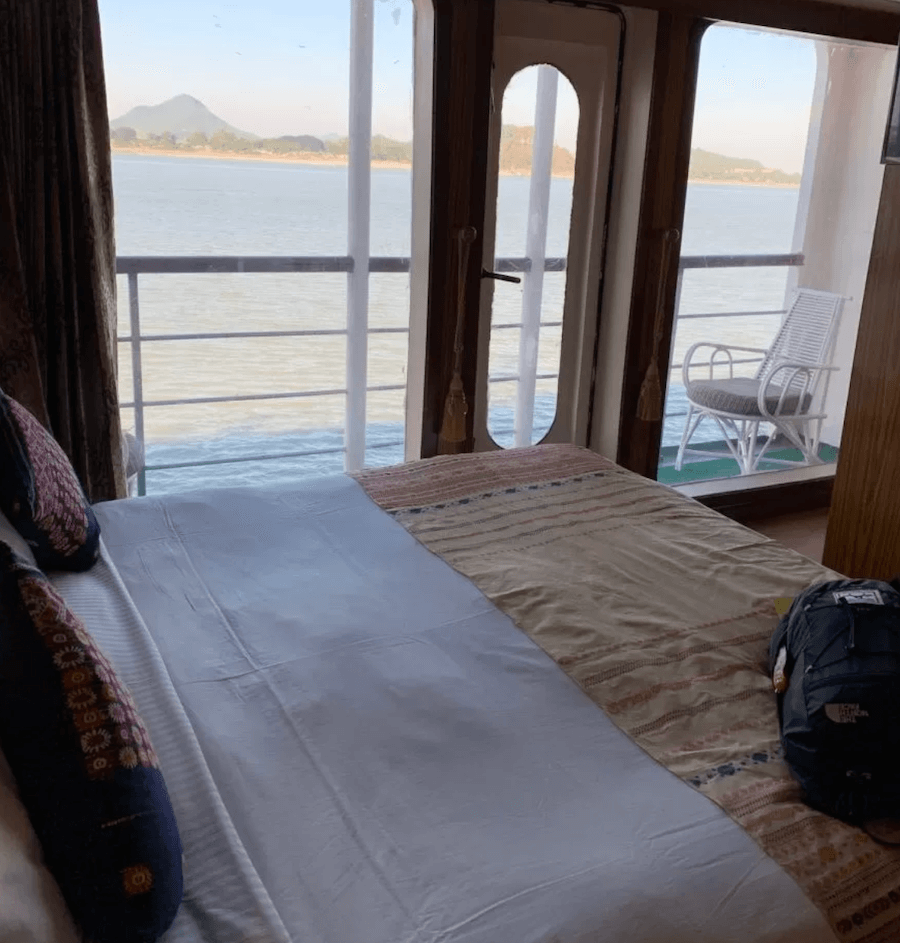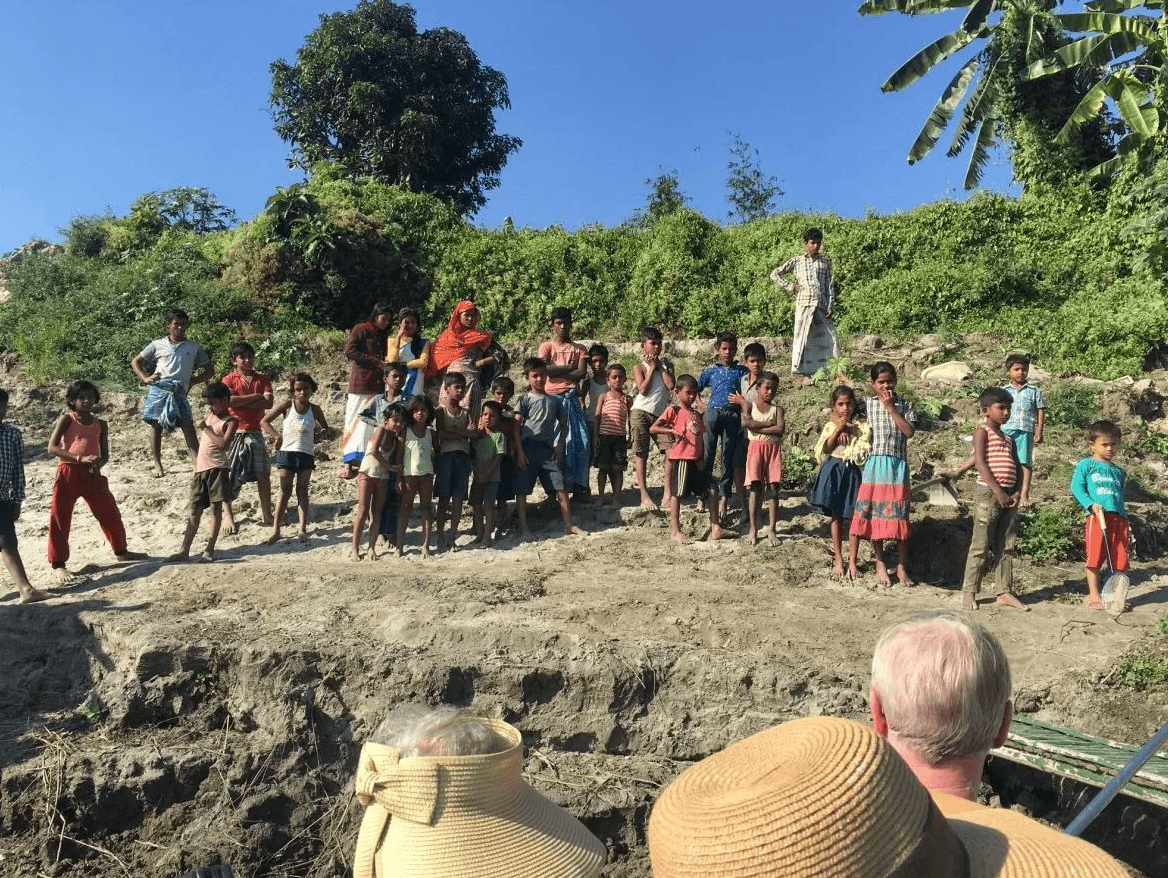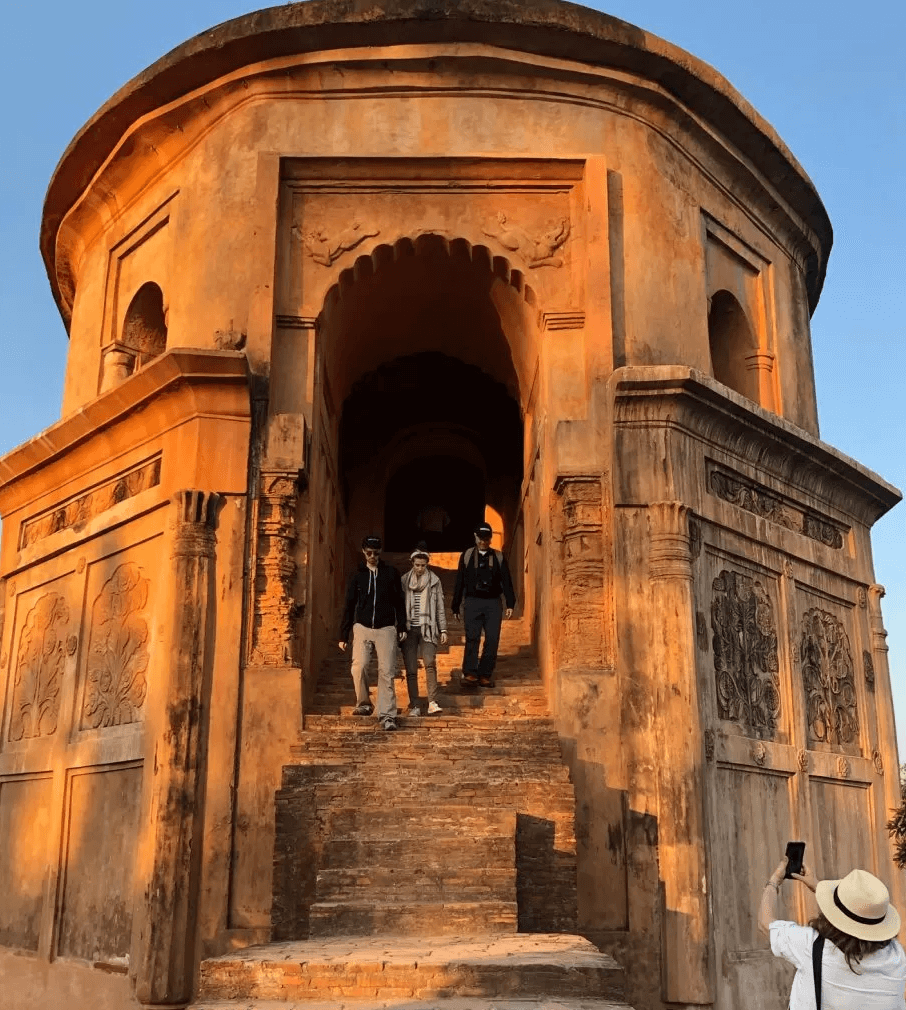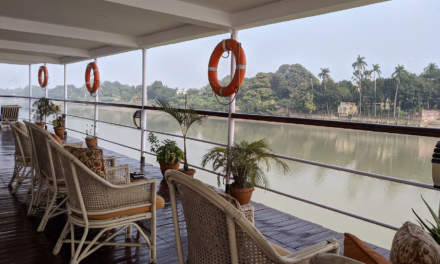Brahmaputra River Cruise.
By Judi Cohen.
Updated Sept 2024
I booked a river cruise on the Lower Ganges with Pandaw Cruises six months prior for my family of four and a couple of friends. You can only imagine my shock on receiving an email a few weeks before departure that the cruise was cancelled. (We were told the boat had not arrived in India from Myanmar in time, as apparently there is a lot of paperwork involved in moving boats from one country to another.)
Given a choice by Pandaw of getting a refund or doing a land tour in India, neither of which interested me, I took it upon myself to fill the 8-day hole in our family’s month-long India adventure. QuirkyCruise’s co-founder Heidi Sarna, and a few other travel colleagues, suggested a Brahmaputra River cruise aboard the 46-passenger MV Mahabaahu.
RELATED: Heidi reviews her Brahmaputra River cruise adventure.
Not only did Pandaw book us on the alternate cruise, but they also covered the costs for changes to our airfare. I never would have imagined that we’d be cruising in a remote part of India rarely visited by tourists, but it wound up being super memorable.
So, here’s my story of our journey on the mighty Brahmaputra River from Guwahati to Jorhat.
Subscribe to our monthly small ship cruise email
Subscribe to QuirkyCruise.com for monthly curated newsletters highlighting our top small cruise ship reviews, round-ups & offers!
The Brahmaputra: No Ordinary River
The Brahmaputra is a destination unto itself. It’s the only river, apart from the Zambezi in Africa, from which you can easily access a game park. Kaziranga National Park is a UNESCO World Heritage site referred to by National Geographic as “the Serengeti of India.”
You’ll see that the Brahmaputra’s ever-shifting sandy banks are also home to colorful birdlife, herds of deer and antelope, and elusive tigers.

The sandy banks of the Brahmaputra River. * Photo: Judi Cohen
With its fast-moving currents originating in the Himalayan mountain range, the water levels rise and fall, and sandbanks form and then disappear, almost as if they were melting before one’s eyes. A small pilot boat accompanied us and used bamboo sticks to test the river depth ahead.
The Brahmaputra River was a fascinating backdrop to a week spotting wildlife and exploring remote villages.
The MV Mahabaahu
Mahabaahu, one of the very few riverboats sailing on the Brahmaputra River, was launched in 2011 by Adventure River Cruises (ARC).
Our home for seven nights was comfortable and unassuming, with a somewhat industrial-looking exterior and a homey interior.
All cabins had large windows, and some, including ours, had a small balcony. We had a comfortable king bed, loads of closet and storage space, as well as a fridge and safe. The bathroom had a surprisingly large shower with strong water pressure.

Judi’s balcony cabin had great views. * Photo: Judi Cohen
While cabins had TVs, none worked, and the air-conditioning units were difficult to control so we were either too hot or too cold. These were small concerns relative to the unique experience.
The ship has five decks, with cabins on the second and third decks. There are two suites, two luxury cabins, seven deluxe cabins, and 12 superior cabins (without balconies). While the ship has a capacity of 46 passengers, we had just 26 guests aboard our week.
All decks are easily accessible from a central staircase. There is also a lift, however, it was out of service during our sailing. Although the weather at this time of year made it too cold to swim, around 22C (71F) degrees during the day and 11C (42F) degrees at night, there was a lovely little pool.

The Mahabaahu has a small pool at the stern near the smokestacks. * Photo: Judi Cohen
The sun deck was the “go to” spot to enjoy the lounge chairs, bar, and a panoramic view of the riverbanks.
Neena, the CEO of ARC, managed every aspect of the guest experience on the ship, and worked closely with her team of 28, including Sandeep, manager of hospitality; Cruise Director Rajeesh; and Mayuresh, destination manager, naturalist and photographer.
There was even a tailor on the boat who made clothing for guests out of fabric sold in the pop-up gift shop in the reception area. My friend had several pants made and was very happy with the results.

Reception area had a pool table and was also used as a pop-up gift shop. * Photo: Judi Cohen
While the ship’s marketing characterizes the MV Mahabaahu as a “luxury ship,” in my opinion, the ship would not be considered luxury by international standards. However, there are very few other tourist-class vessels that traverse the Brahmaputra, as cruising along the rivers in India has only recently become practical and fashionable.
Experientially, this small-ship Brahmaputra River cruise met all my expectations.
MV Mahabaahu Inclusions
All shore excursions and transfers to and from the airports were included. Bottled water was freely available at no charge; while alcoholic beverages were available in the bars and in the dining room at reasonable prices.
A recommended tipping guide for the crew and staff was provided and was optional at the end of the cruise. Ayurvedic massages in the spa were also extra, though reasonably priced.
Fellow Passengers
Passengers ranged in age from 6 to 65 and were all very adventurous. The well-travelled group was English-speaking from Australia, England, Singapore, Denmark, Canada, and some from India exploring their own country.
The ages on our cruise skewed a bit lower than normal as we were cruising at Christmas, when families travel together. Children are rare on this cruise.
Daily Routine
My general routine started with an hour of morning yoga, led by Neena, on the sundeck. This was an invigorating, crisp way to start the day, and nearly half the guests tried yoga at least once.
There was a morning excursion, departing by tender, with a return for a buffet lunch. Following lunch, we either relaxed on the ship or set out again on an afternoon excursion. At some point each day, we could attend an informative short lecture by Mayuresh, highlighting the next day’s stops.
In the evening, cocktails were served (at a charge) in the Soma Lounge bar and following dinner we returned to the lounge for mingling, movies, games like getting the ring over the bottle (to win a bottle of beer), board games and more drinks.
Dining with Local Flair & Flavours
The Mungri Mingrum dining room featured large windows and warm woods. I must admit, however, I would have enjoyed some al fresco dining, particularly at lunch. In fact, some of the guests did take their food up to the sundeck for a change of scenery.
Breakfast was available between 8-10am, with Indian and international choices, including an omelette and pancake station.
Lunch buffets included tasty curries, varieties of paneer and rice, fresh local vegetables and salads, Indian breads, and tempting Indian sweets.

Delicious Indian fare. * Photo: Judi Cohen
Neena, the boat’s general manager and cruise director, quickly learned about our tolerance for spice and food preferences. She guided guests with food allergies and special orders were accommodated without hesitation.
Dinner was a sit-down meal. Orders were taken at lunch each day for our dinner choices (vegetarian, non-vegetarian, Continental and Indian Cuisine). Highlights included the palak paneer, butter chicken, paneer tikka masala, and the traditional Assamese dishes.
Following dinner, the lounge was open again for after-dinner drinks, however we often retreated to our cabin for a good night’s sleep after a tiring day.
Brahmaputra River Cruise Excursions
We flew from Kolkata to Guwahati, the largest city in the Indian state of Assam. Bordered on the northeast by Bhutan, south by Bangladesh, and west by Bengal, Assam is known for the vast Kaziranga game park.
Our group was met at the airport and transferred to the boat for our Brahmaputra River cruise, with a short stop at the Hindu Kamakhya Temple. According to legend, this is where the gods Sati and Shiva met, and it remains an important center for followers of Tantra, or the esoteric traditions of Hinduism and Buddhism.

The lovely welcome aboard ritual entails being given an Assamese scarf and a marigold garland. * Photo: Judi Cohen
As we travelled upstream, we visited a number of small villages. Approaching each one in our open-top tenders, we were greeted by curious families with many children watching as we trundled from the tenders and along the sloped sandy shores holding onto make-shift bamboo railings.
RELATED: Check out Judi’s tips to help you prepare for your very own Brahmaputra River adventure.
Day 1: Embarkation & Peacock Island
Our first visit was to Peacock Island, a tiny tree-covered island with a small temple and one outgoing Golden Langur monkey, who came down from the trees to pose for photos.

A cheeky Golden Langur on Peacock Island. * Photo: Judi Cohen
The sunset views from the island cast a stunning golden hue across the water as we returned to the ship.

Gorgeous Brahmaputra sunsets were daily affairs. * Photo: Judi Cohen
Day 2: Bangla Village
Our next visit was to Upera, a Bangla Muslim farming village. We walked through sprawling fields of yellow mustard flowers and cabbages, passed cows and goats, and were struck by how beautiful the girls and women were.
Always asking permission to take photos, the villagers were happy to oblige, and they all wanted us to show them the photos, giggling with us.

The Bangla Village Welcome Wagon! * Photo: Judi Cohen
Day 3: Sea Day on our Brahmaputra River Cruise
Our third day became a sea-day due to unexpectedly foggy conditions, which we were told only occur on 19 days out of each season.
No problem, everyone welcomed the relaxation time. I used my afternoon to try an exceptional two-hour Ayurvedic massage for the first time. Very different from other massages I have had, the Ayervedic holistic techniques focused on the relief of both physical and emotional stress.
It was heavenly having four-hands (two people) apply gallons of hot essential oils and a variety of herbs as they massaged every inch of my body. While I was lying directly on a hard teakwood slab table, I felt far more relaxed than I have ever felt during a massage and even nodded off a couple of times, something I normally can’t do while being massaged.
My daughter and I each had two massages over the course of the week.
Day 4: Kaziranga National Park
Elephant-back Safari & Jeep Safari
The highlight of our Brahmaputra River cruise was the safari experience over two days in the 430-square-mile Kaziranga National Park, home to the endangered one-horned white rhinoceros. We were told poaching is ever-present and a controversial “shoot-to-kill” policy is in place if rangers discover poachers. Despite this, poachers do still hunt rhinos, although thankfully we did not encounter any.
Nobody minded the 3am wake-up as we headed out in four-wheel drive vehicles to Kaziranga for an elephant-back safari. In twos and threes we climbed on top of these majestic elephants escorted by mahouts and armed guards for a 90-minute safari. As the red sun came up, we watched the mist rising from the tall elephant grass, with warm rays streaming through the mist.

Judi & Lawrence on an elephant Back safari in the misty morning. * Photo: Judi Cohen
While I was conflicted about riding an elephant, we were told that these elephants do only two morning rides, and then are free to graze in the grasslands for the rest of the day. Further, their babies were allowed to playfully follow alongside their mothers.
As the one-horned rhinos, along with wild boars, deer, antelope and buffalo, appeared out of the morning mist, we saw mounds of bright pink flowers that grow on rhino dung. The rhinos were an awesome sight, looking downright prehistoric with their many folds of “armour.”
Riding these elephants at sunrise and seeing the one-horned rhinos up close in the tall grasses was one of the most memorable experiences in all my years of travelling.

Seeing a one-horned white rhino up close is a thrill. * Photo: Alison Cohen
In the afternoon we set out on a Jeep safari. Unfortunately, the park was busy with tourists visiting Kaziranga over Christmas and New Year’s, and the jeeps were following one another closely on a narrow dusty road, which created a less than optimal experience.

Judi and her family on the jeep safari. * Photo: Judi Cohen
Nonetheless we were glad to spot more rhinos, deer and buffalos. There are 3,400 wild water buffalo worldwide, with half living in Kaziranga. And, the eastern swamp deer are only found in Assam. While I am not a birder, I still enjoyed seeing hornbills, kingfishers, and giant storks.
Tea & Jute
On the way back to the ship, we stopped to watch a traditional Assamese dance performance with colourful costumes at a tea plantation.
We also visited the a jute factory. Dating back to 1959, this was a genuine throwback. Walking through the factory with our masks on and ear plugs in, I could only imagine this factory operating in earlier times, with its archaic softening, spinning, twisting and spool-winding equipment.
The factory employs over 300 men, and while the government could mechanize jute production, we were told by our guide that it keeps it in operation to support the workers, whose jobs are coveted.
Day 5: Bishwanath Ghat & Boat Safari
In the morning, we took our tender and visited Bishwanath Ghat, a weaving village, with looms in almost every house.
The bright coloured textiles made the village look beautiful and they, of course, were for sale. Many of the passengers tried on the clothing and wrapped themselves in fabrics before carefully choosing their purchases.
The children played happily in the dusty laneways and gave us a very warm welcome.

Sarees and fabrics for sale. * Photo: Judi Cohen
A boat safari using our tender in the eastern range of Kaziranga National Park capped off our day. Our naturalist, Mayuresh, told us that a few months prior they spotted a tiger at the base of the steep cliffs.
While we were hopeful, there were no elusive Bengal tigers to be seen. We did see many birds, deer and buffalo as we cruised upstream against the strong current.
That night we anchored at a large sandbank where we made a campfire. We walked across the narrow gangway onto the sandbank and were welcomed to “the Island” with drinks, music and a barbecue.
We played a lively game of charades under the stars, and capped off the evening by releasing traditional lanterns into the river while making a wish.
It was a magical evening.

Lovely sunsets nearly every day. * Photo: Judi Cohen
Day 6: Mishing Village
Our last two days featured visits to two unique villages. The first was the ethnic village of the Mishing with their bamboo homes on stilts. Their ancestry can be traced to Tibet and they are followers of Donyi-Polo animistic worship.
We stopped in the centre of the village to watch a demonstration on the tying of the Mishing’s traditional clothing. My 34-year-old son was dressed by the villagers in a dhoti and kurta, with a red and white traditional scarf, while one of our shipmates was dressed in a colourful silk Mekhela Chaadar sari.
The children followed my son, still dressed in his dhoti and kurta, for the rest of the day. I am not sure who enjoyed this more, my son or all of the children!

Judi’s son Dustin dressed in a kurta during a stop at the Mishing village. * Photo: Judi Cohen
To top off a perfect day we were treated to an Assamese-themed evening, which included being outfitted in local garb by Neena, dancing in the lounge with cocktails, and a traditional Assamese dinner. The maasai tinga (fish curry) and baanhgajor lagos kukura (chicken with bamboo shoots) were very tasty.
Just like Cinderella, we took off our beautiful outfits (mine was a stunning lime green sari and my daughter’s was rich red and purple), and placed them in front of our cabin doors before we went to bed, and they were gone by the morning.
This was another very special and memorable night for all of us on our Brahmaputra River cruise.
Day 7: Majuli Island & Sivasagar
Our last sailing day proved to be busy with a morning visit to Majuli Island for immersion into the Neo-Vaishnav Hindu sect who calls this island home. The Neo-Vaishnavite movement started in Assam in the 16th century and reached its climax in the middle of the 17th century. It had missionary components lifting up the lower classes and minimizing caste distinctions.
We learned about the island’s many different dance forms and philosophies, and at the Kamalabari Satra temple, we watched an intriguing and complex dance performance by priests called “Gayan Bayan.”

Dancing priests performed the entrancing “Gayan Bayan” music. * Photo: Judi Cohen
The afternoon excursion took us by road on a five-hour visit to Sivasagar to learn about the history of the Ahom Kingdom, which had 600 years of influence on the history of Assam.
We climbed the Sivasagar Savadol structure built by the Ahoms and enjoyed seeing the local street activities leading to the temple, where we had blessing strings tied on our wrists.

The beautiful Sivasagar Savadol. * Photo: Judi Cohen
After our return to the ship, free cocktails in the Soma Lounge and a farewell dinner was served. We enjoyed the cruise video that Mayuresh put together. A USB drive with professional photos from the week was available for 2300 rupees. (about $33 USD)
Day 8: Time to Say Goodbye …
Our final stop was visiting a tea plantation for a home-made lunch and a presentation by a tea master. We met the owners and toured their property.
After lunch we were whisked off to the Jorhat Military Airport for our flight to Delhi.
Although this wasn’t the original Lower Ganges cruise that we had planned, this Brahmaputra River cruise offered us a glimpse into an unexpectedly vibrant, diverse, and geographically beautiful area of northeast India that was not at all on our radar.
I look forward to returning to the region again one day.
For booking details, visit Far Horizons Tours.
RELATED: Heidi reviews her Brahmaputra River cruise.
RELATED: Judi shares her tips to help you prepare for a Brahmaputra River adventure.
Don’t miss a post about small-ship cruising, subscribe to QuirkyCruise.com for monthly updates & special offers!
© This article is protected by copyright, no part may be reproduced by any process without written permission from the author. All Rights Reserved. QuirkyCruise.com.














 HEIDI SARNA
HEIDI SARNA












What an incredible adventure you had! It looks like it is a full immersion into the local culture. Fabulous.
It really was very special!